GA3 and Hand Thinning Improves Physical, Chemical Characteristics, Yield and Decrease Bunch Compactness of Sultanina Grapevines (Vitis vinifera L.)
Abstract
1. Introduction
2. Materials and Methods
2.1. Plant Materials and Experimental Design
2.2. Measurements
2.2.1. Leaf Chlorophyll Content (SPAD Units)
2.2.2. Pruning Weight (kg)
2.2.3. Yield and Its Components
2.2.4. Yield Increasing (%)
2.2.5. Physical Characteristics of Clusters
2.2.6. Chemical Characteristics of Berries
2.3. Statistical Analyses
3. Results
3.1. Effect of Hand Thinning and GA3 Spray for Sizing on Leaf Chlorophyll Content and Pruning Weight
3.2. Effect of Hand Thinning and GA3 for Sizing on Yield and Its Components
3.3. Effects of Hand Thinning and GA3 Spray on Cluster and Berry Quality
3.3.1. Effects of Hand Thinning and GA3 Spray on Cluster Length, Width, Number of Berries/Cluster, and Compactness
3.3.2. Effect of Hand Thinning and GA3 on Volume and Weight of Berries
3.3.3. Effect of Hand Thinning and GA3 Spray on Berry Length, Diameter, Shape Index, and Firmness
3.3.4. Hand Thinning and GA3 Spray on Berry Chemical Characteristics
4. Conclusions
Author Contributions
Funding
Institutional Review Board Statement
Informed Consent Statement
Data Availability Statement
Acknowledgments
Conflicts of Interest
Abbreviations
| Min. temp | minimum temperature |
| Mean Temp | mean annual temperature |
| Max: temp | maximum temperature |
| RH | relative humidity |
| GA3 | Gibberellic acid |
| Ppm | Parts per million |
| T | treatment |
| g | gram |
| TSS | Total soluble solids |
References
- Kedage, V.V.; Tilak, J.C.; Dixit, G.B.; Devasagayam, T.P.A.; Mhatre, M. A Study of Antioxidant Properties of Some Varieties of Grapes (Vitis vinifera L.). Crit. Rev. Food Sci. Nutr. 2007, 47, 175–185. [Google Scholar] [CrossRef]
- Senthilkumar, S.; Vijayakumar, R.M.; Soorianathasundaram, K. Pre-Harvest Implications and Utility of Plant Bioregulators on Grape: Areview. Plant Arch. 2018, 18, 19–27. [Google Scholar]
- FAOSTAT—Food and Agriculture Organization Corporate. Statistical Database (2020) Food and Agriculture Organization of the United Nations. Crops 2020. [Google Scholar] [CrossRef]
- FAO. World Food and Agriculture—Statistical Yearbook 2020; FAO: Rome, Italy, 2020; ISBN 978-92-5-133394-5. [Google Scholar]
- Ibrahim, R.E.; El-Akad, M.M.; Rizkalla, M.K. Effect of Spraying Gibberellic Acid and Caffeic Acid on Yield and Fruit Quality of White Banaty (Thompson Seedless) Grape Cultivar. SVU-Int. J. Agric. Sci. 2021, 3, 132–140. [Google Scholar] [CrossRef]
- Dry, I.B.; Davies, C.; Dunlevy, J.D.; Smith, H.M.; Thomas, M.R.; Walker, A.R.; Walker, R.R.; Clingeleffer, P.R. Development of New Wine-, Dried- and Tablegrape Scions and Rootstocks for Australian Viticulture: Past, Present and Future. Aust. J. Grape Wine Res. 2022, 28, 177–195. [Google Scholar] [CrossRef]
- Elatafi, E.; Doaa, M.H.; Samra, N.R. Improving Yield and Bunches Quality of Sultana ‘H4 Strain’ Grapevines. J. Plant Prod. 2022, 13, 661–666. [Google Scholar] [CrossRef]
- Belal, B. Improvement of Physical and Chemical Properties of Thompson Seedless Grapes (H4 Strain) by Application of Brassinolide and Gibberellic Acid. Egypt. J. Hortic. 2019, 46, 251–262. [Google Scholar] [CrossRef]
- Rademacher, W. Plant Growth Regulators: Backgrounds and Uses in Plant Production. J. Plant Growth Regul. 2015, 34, 845–872. [Google Scholar] [CrossRef]
- Guzmán, Y.; Pugliese, B.; González, C.V.; Travaglia, C.; Bottini, R.; Berli, F. Spray with Plant Growth Regulators at Full Bloom May Improve Quality for Storage of “Superior Seedless” Table Grapes by Modifying the Vascular System of the Bunch. Postharvest Biol. Technol. 2021, 176, 111522. [Google Scholar] [CrossRef]
- Abu-Zahra, T.R.; Salameh, M. N Influence of Gibberellic Acid and Cane Girdling on Berry Size of Black Magic Grape Cultivar. Middle-East J. Sci. Res. 2012, 11, 718–722. [Google Scholar]
- Dimovska, V.; Petropulos, V.I.; Salamovska, A.; Ilieva, F. Flame Seedless Grape Variety (Vitis vinifera l.) and Different Concentration of Gibberellic Acid (GA3). Bulg. J. Agric. Sci. 2014, 20, 127–132. [Google Scholar]
- Abu-Zinada, I.A. Effect of GA3, Girdling or Pruning on Yield and Quality of “Parletta” Seedless Grape. Am. J. Agric. For. 2015, 3, 230. [Google Scholar] [CrossRef]
- Sangeetha, J.; Sivachandiran, S.; Selvaskanthan, S. Influence of Different Application Methods of Gibberellic Acid (GA3) on Quality and Yield of Grapes (Vitis vinifera L.). Int. J. 2015, 2, 10–14. [Google Scholar]
- Xie, S.; Liu, Y.; Chen, H.; Yang, B.; Ge, M.; Zhang, Z. Effects of Gibberellin Applications before Flowering on the Phenotype, Ripening, and Flavonoid Compounds of Syrah Grape Berries. J. Sci. Food Agric. 2022, 102, 6100–6111. [Google Scholar] [CrossRef]
- Kok, D. Variation in Total Phenolic Compounds, Anthocyanin and Monoterpene Content of ‘Muscat Hamburg’ Table Grape Variety (V. vinifera L.) as Affected by Cluster Thinning and Early and Late Period Basal Leaf Removal Treatments. Erwerbs-Obstbau 2016, 58, 241–246. [Google Scholar] [CrossRef]
- Sivilotti, P.; Falchi, R.; Vanderweide, J.; Sabbatini, P.; Bubola, M.; Vanzo, A.; Lisjak, K.; Peterlunger, E.; Herrera, J.C. Yield Reduction through Cluster or Selective Berry Thinning Similarly Modulates Anthocyanins and Proanthocyanidins Composition in Refosco Dal Peduncolo Rosso (Vitis vinifera L.) Grapes. Sci. Hortic. 2020, 264, 109166. [Google Scholar] [CrossRef]
- Hanni, E.; Lardschneider, E.; Kelderer, M. Alternatives to the Use of Gibberellins for Bunch Thinning and Bunch Compactness Reduction on Grapevine. Acta Hortic. 2013, 978, 335–346. [Google Scholar] [CrossRef]
- Gil, M.; Esteruelas, M.; González, E.; Kontoudakis, N.; Jiménez, J.; Fort, F.; Canals, J.M.; Hermosín-Gutiérrez, I.; Zamora, F. Effect of Two Different Treatments for Reducing Grape Yield in Vitis vinifera Cv Syrah on Wine Composition and Quality: Berry Thinning versus Cluster Thinning. J. Agric. Food Chem. 2013, 61, 4968–4978. [Google Scholar] [CrossRef]
- Preszler, T.; Schmit, T.M.; Vanden Heuvel, J.E. Cluster Thinning Reduces the Economic Sustainability of Riesling Production. Am. J. Enol. Vitic. 2013, 64, 333–341. [Google Scholar] [CrossRef]
- Afshari-Jafarbigloo, H.; Eshghi, S.; Gharaghani, A. Cluster and Berry Characteristics of Grapevine (Vitis vinifera L.) as Influenced by Thinning Agents and Gibberrelic Acid Applications. Int. J. Hortic. Sci. Technol. 2020, 7, 377–385. [Google Scholar] [CrossRef]
- Zhuang, S.; Tozzini, L.; Green, A.; Acimovic, D.; Howell, G.S.; Castellarin, S.D.; Sabbatini, P. Impact of Cluster Thinning and Basal Leaf Removal on Fruit Quality of Cabernet Franc (Vitis vinifera L.) Grapevines Grown in Cool Climate Conditions. HortScience 2014, 49, 750–756. [Google Scholar] [CrossRef]
- Roberto, S.R.; Borges, W.F.S.; Colombo, R.C.; Koyama, R.; Hussain, I.; de Souza, R.T. Berry-Cluster Thinning to Prevent Bunch Compactness of “BRS Vitoria”, a New Black Seedless Grape. Sci. Hortic. 2015, 197, 297–303. [Google Scholar] [CrossRef]
- Song, C.Z.; Wang, C.; Xie, S.; Zhang, Z.W. Effects of Leaf Removal and Cluster Thinning on Berry Quality of Vitis vinifera Cultivars in the Region of Weibei Dryland in China. J. Integr. Agric. 2018, 17, 1620–1630. [Google Scholar] [CrossRef]
- Wegher, M.; Faralli, M.; Bertamini, M. Cluster-Zone Leaf Removal and GA3 Application at Early Flowering Reduce Bunch Compactness and Yield per Vine in Vitis vinifera Cv. Pinot Gris. Horticulturae 2022, 8, 81. [Google Scholar] [CrossRef]
- Petoumenou, D.G.; Patris, V.-E. Effects of Several Preharvest Canopy Applications on Yield and Quality of Table Grapes (Vitis vinifera L.) Cv. Crimson Seedless. Plants 2021, 10, 906. [Google Scholar] [CrossRef] [PubMed]
- Domingos, S.; Nobrega, H.; Raposo, A.; Cardoso, V.; Soares, I.; Ramalho, J.C.; Leitão, A.E.; Oliveira, C.M.; Goulao, L.F. Light Management and Gibberellic Acid Spraying as Thinning Methods in Seedless Table Grapes (Vitis vinifera L.): Cultivar Responses and Effects on the Fruit Quality. Sci. Hortic. 2016, 201, 68–77. [Google Scholar] [CrossRef]
- Gao, X.; Wu, M.; Sun, D.; Li, H.; Chen, W.; Yang, H.; Liu, F.; Wang, Q.; Wang, Y.; Wang, J.; et al. Effects of Gibberellic Acid (GA3) Application before Anthesis on Rachis Elongation and Berry Quality and Aroma and Flavour Compounds in Vitis vinifera L. ‘Cabernet Franc’ and ‘ Cabernet Sauvignon ’ Grapes. J. Sci. Food Agric. 2020, 100, 3729–3740. [Google Scholar] [CrossRef]
- Benati, J.A.; Nava, G.; Mayer, N.A. Spad Index for Diagnosis of Nitrogen Status in ‘Esmeralda’ Peach. Rev. Bras. Frutic. 2021, 43, e-093. [Google Scholar] [CrossRef]
- Markwell, J.; Osterman, J.C.; Mitchell, J.L. Calibration of the Minolta SPAD-502 Leaf Chlorophyll Meter. Photosynth Res 1995, 46, 467–472. [Google Scholar] [CrossRef]
- Sabry, G.H.; Bedrech, S.A.; Ahmed, O.A. Effect of Cane Length and Number on Bud Behavior, Growth and Productivity in Red Globe and Black Monukka Grape Cultivars. J. Hortic. Sci. Ornam. Plants 2020, 12, 182–192. [Google Scholar] [CrossRef]
- Chen, X.; Ding, H.; Yuan, L.-M.; Cai, J.-R.; Chen, X.; Lin, Y. New Approach of Simultaneous, Multi-Perspective Imaging for Quantitative Assessment of the Compactness of Grape Bunches: Simultaneous Multi-Perspective Imaging of Bunches. Aust. J. Grape Wine Res. 2018, 24, 413–420. [Google Scholar] [CrossRef]
- McKie, V.A.; McCleary, B.V. A Novel and Rapid Colorimetric Method for Measuring Total Phosphorus and Phytic Acid in Foods and Animal Feeds. J. AOAC Int. 2016, 99, 738–743. [Google Scholar] [CrossRef]
- Gomez, K.A.; Gomez, A.A. Statistical Procedures for Agricultural Research. In An International Rice Research Institute Book, 2nd ed.; Wiley: New York, NY, USA, 1984; ISBN 978-0-471-87931-2. [Google Scholar]
- Duncan, D.B. Multiple Range and Multiple F Tests. Biometrics 1955, 11, 1–42. [Google Scholar] [CrossRef]
- Shaker, G.S. Effect of Vegetative Shoot Thinning on Growth, Yield and Bunch Quality of Black Monukka and Red Globe Grape Cultivars. Egypt. J. Hortic. 2015, 41, 299–311. [Google Scholar] [CrossRef]
- Fawzi MI, F.; Hagagg, L.F.; Shahin MF, M.; El-Hady, E.S. Effect of Hand Thinning, Girdling and Boron Spraying Application on, Vegetative Growth, Fruit Quality and Quantity of Thompson Seedless Grapevines. Middle East J. Agric. Res. 2019, 8, 506–513. [Google Scholar]
- Scheiner, J.; Anciso, J.; Westover, F. Impact of Training System on ‘Blanc Du Bois’ Vegetative Growth, Yield Components and Fruit Composition. Vitic. Data J. 2020, 2, e53118. [Google Scholar] [CrossRef]
- Noori, A.M.; Lateef, M.A.A.; Muhsin, M. Effect of Phosphorus and Gibberellic Acid on Growth and Yield of Grape (Vitis vinifera L.). Res. Crops 2018, 19, 643–648. [Google Scholar] [CrossRef]
- Sun, Q.; Sacks, G.L.; Lerch, S.D.; vanden Heuvel, J.E. Impact of Shoot and Cluster Thinning on Yield, Fruit Composition, and Wine Quality of Corot Noir. Am. J. Enol. Vitic. 2012, 63, 49–56. [Google Scholar] [CrossRef]
- Gowda, V.N.; Shyamalamma, S.; Kannolli, R.B. Influence of GA3 on growth and development of ‘Thompson Seedless’ grapes (Vitis vinifera L.). Acta Hortic. 2006, 727, 239–242. [Google Scholar] [CrossRef]
- Chai, L.; Li, Y.; Chen, S.; Perl, A.; Zhao, F.; Ma, H. RNA Sequencing Reveals High Resolution Expression Change of Major Plant Hormone Pathway Genes after Young Seedless Grape Berries Treated with Gibberellin. Plant Sci. 2014, 229, 215–224. [Google Scholar] [CrossRef]
- Ergönül, O.; Özer, C. Effects of Gibberelic Acid (GA3) and Berry Thinning on Güz Gülü, Özer Beyazı, Süleymanpaşa Beyazı and Tekirdağ Misketi Seedless Table Grape Cultivars. Vitic. Stud. 2022, 1, 1–10. [Google Scholar] [CrossRef]
- Radwan, E.; Khodair, O.; Silem, A. Effect of Some Compounds Spraying on Fruiting of Superior Seedless Grapevines under Assiut Conditions. J. Plant Prod. 2019, 10, 59–64. [Google Scholar] [CrossRef]
- Shah, S.; Khan, A.; Khan, M.A.; Farooq, K.; Riaz, M.; Javed, M.A.; Gurmani, Z.A.; Hussain, A.; Iftikhar, M. Effects of gibberellic acid on growth, yield and quality of grape cv. Prlet. Int. J. Biol. Biotechnol. 2015, 12, 499–503. [Google Scholar]
- Almanza-merchán, P.J.; Fischer, G.; Serrano-Cely, P.A.; Balaguera-López, H.E.; Galvis, J.A. Effects of Leaf Removal and Cluster Thinning on Yield and Quality of Grapes (Vitis vinifera L., Riesling × Silvaner) in Corrales, Boyaca (Colombia) Efecto Del Deshoje y Del Raleo de Racimos Sobre El Rendimiento y La Calidad de Las. Agron. Colomb. 2011, 29, 35–42. [Google Scholar]
- Elgendy, R.S.S.; Shaker, G.S.; Ahmed, O.A. Effect of Foliar Spraying with Gibberellic Acid and/or Sitofex on Bud Behavior, Vegetative Growth, Yield and Cluster Quality of Thompson Seedless Grapevines. J. Am. Sci. 2012, 8, 21–34. [Google Scholar]
- Tardaguila, J.; Petrie, P.R.; Poni, S.; Diago, M.P.; Martinez de Toda, F. Effects of Mechanical Thinning on Yield and Fruit Composition of Tempranillo and Grenache Grapes Trained to a Vertical Shoot-Positioned Canopy. Am. J. Enol. Vitic. 2008, 59, 412–417. [Google Scholar] [CrossRef]
- Rather, J.A.; Wani, S.H.; Haribhushan, A.; Bhat, Z.A. Influence of Girdling, Thinning and GA3 on Fruit Quality and Shelf Life of Grape (Vitis vinifera) cv. Perlette. Elixir Agric. 2011, 41, 5731–5735. [Google Scholar]

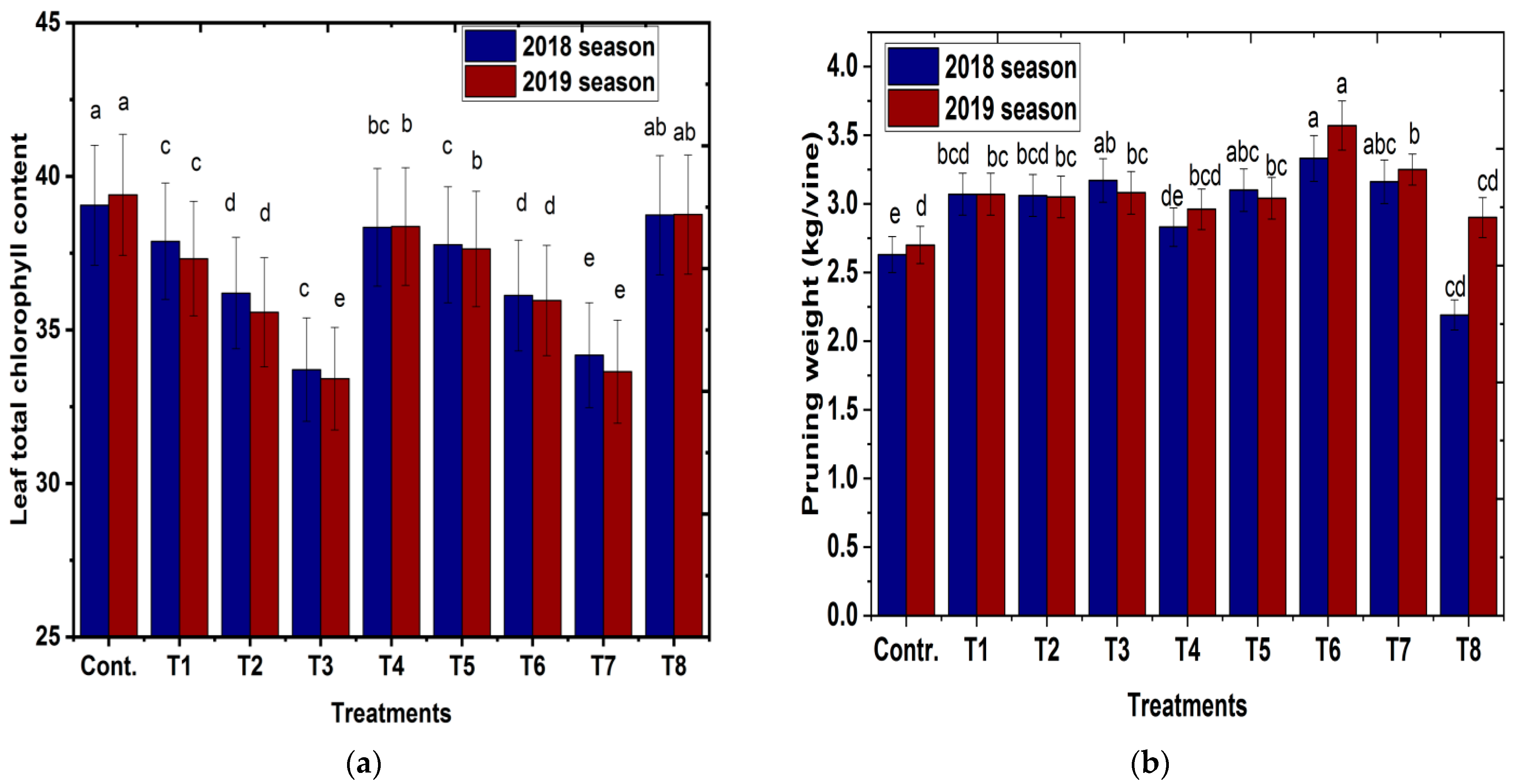
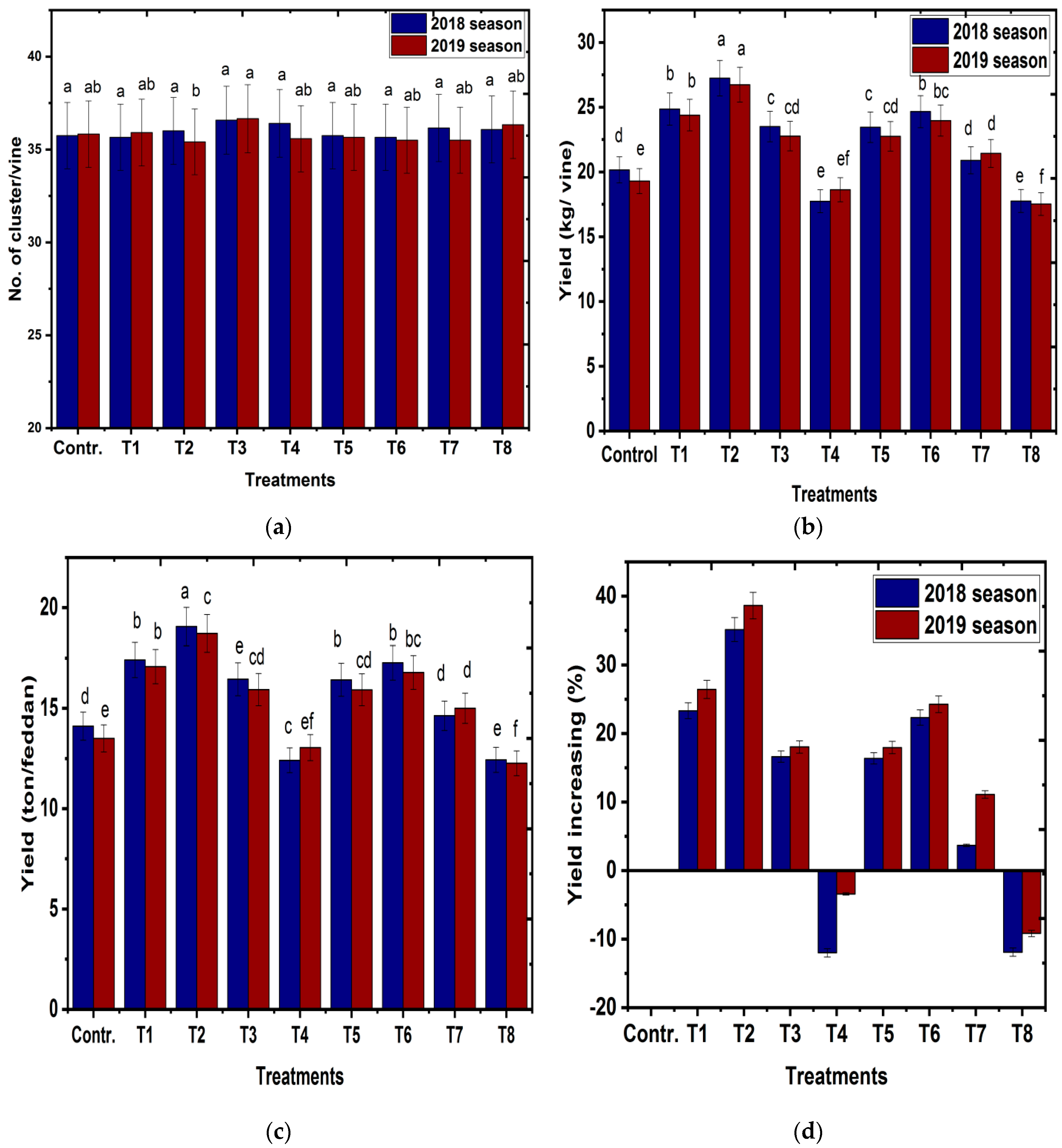
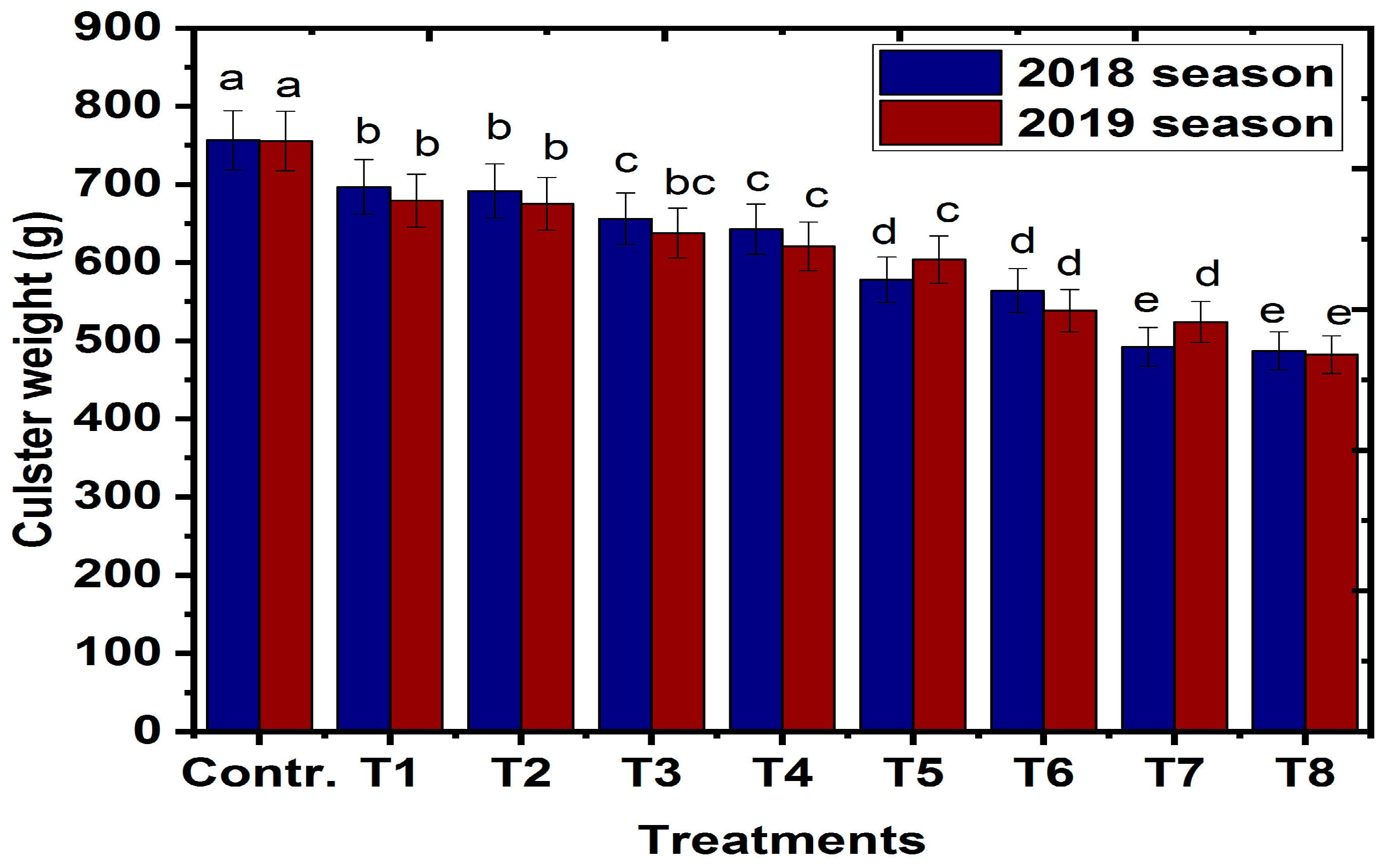


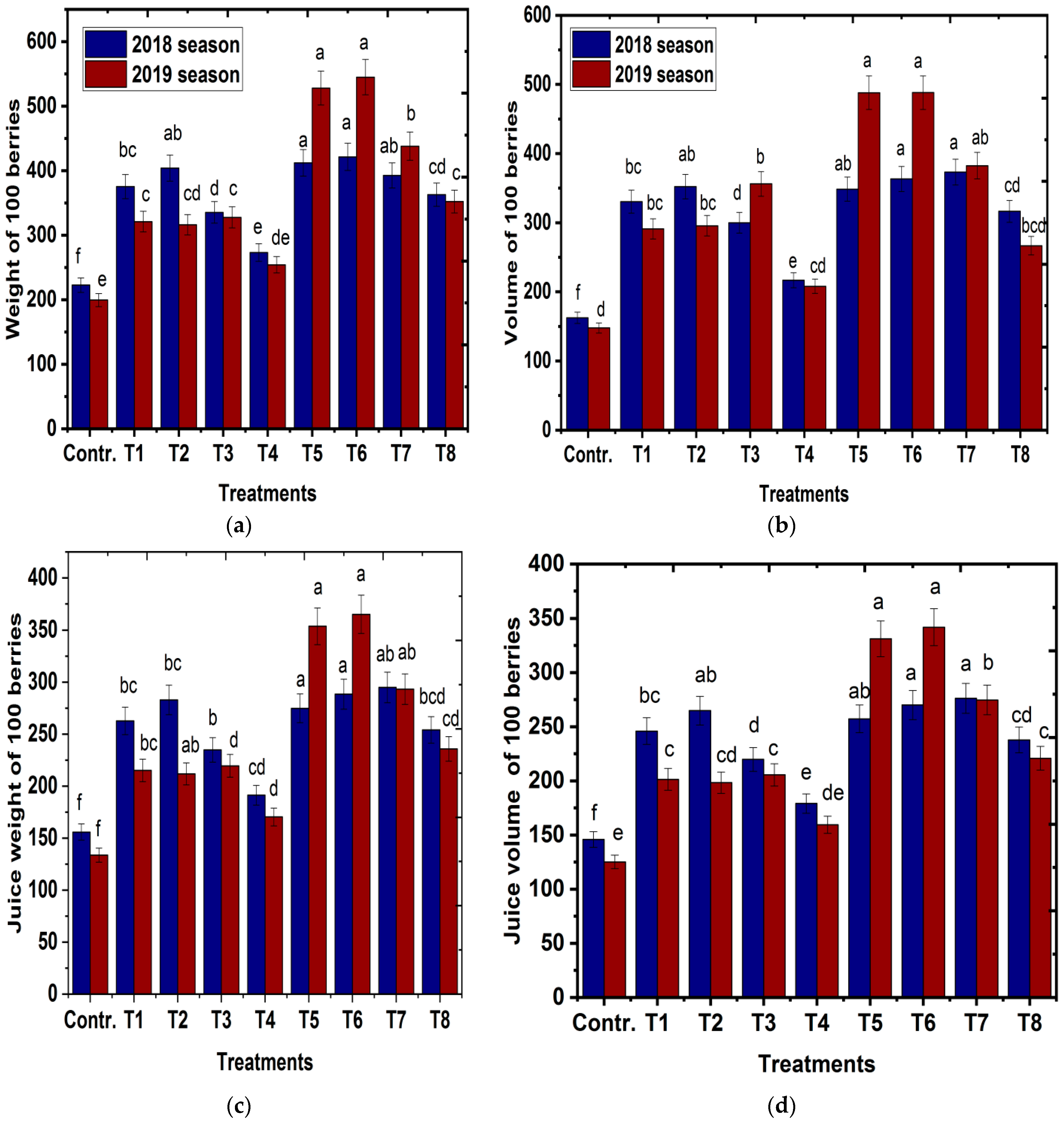

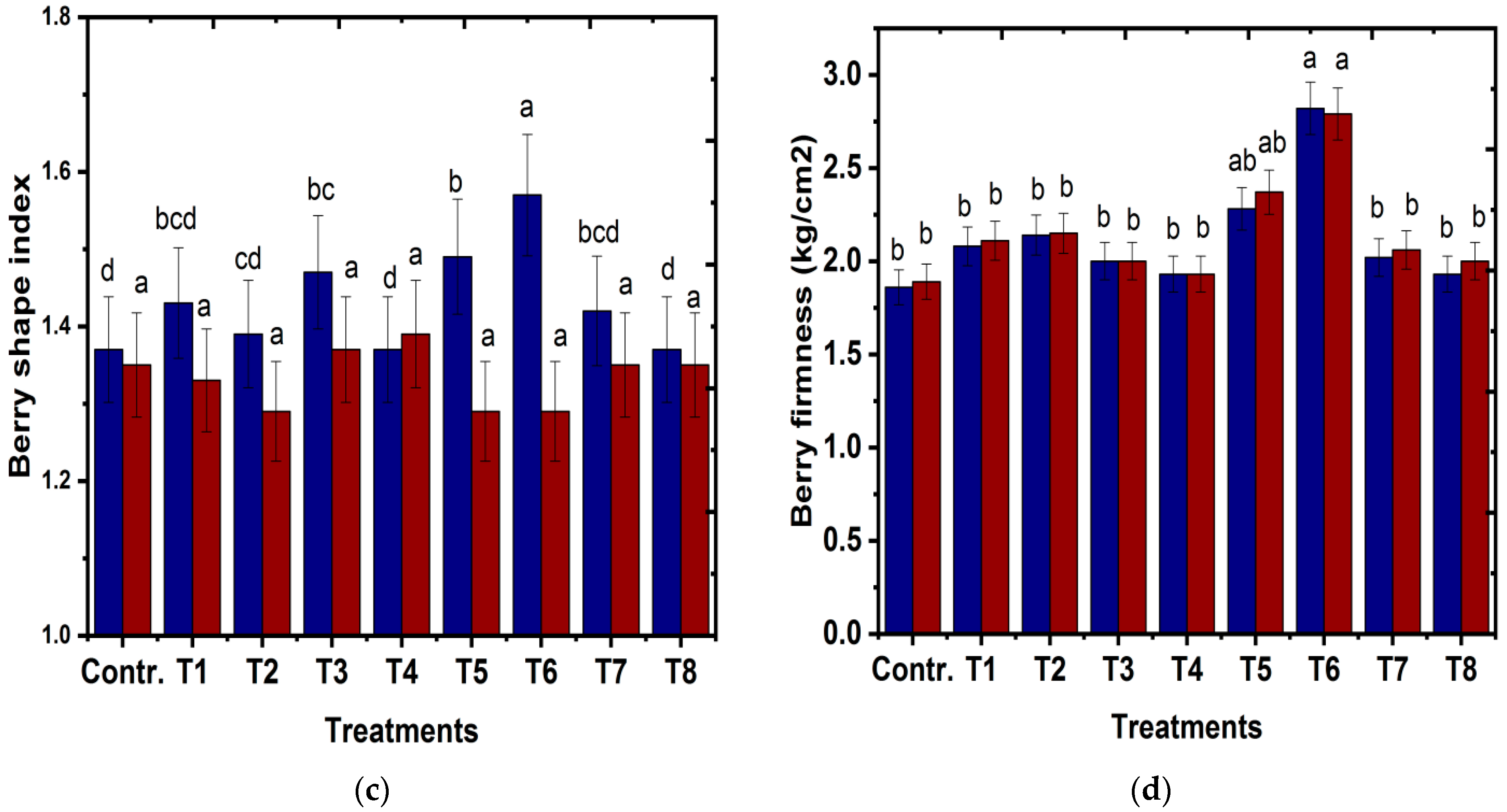


| Treatments No. | Hand Thinning (%) | GA3 Foliar Spray (ppm) |
|---|---|---|
| Control | Without removing any shoulders of the cluster | 0.0 |
| T1 | 25% of cluster shoulders were removed | 20 |
| T2 | 25% of cluster shoulders were removed | 30 |
| T3 | 25% of cluster shoulders were removed | 40 |
| T4 | 50% of cluster shoulders were removed | 0.0 |
| T5 | 50% of cluster shoulders were removed | 20 |
| T6 | 50% of cluster shoulders were removed | 30 |
| T7 | 50% of cluster shoulders were removed | 40 |
| T8 | 50% of cluster shoulders were removed | 0.0 |
Disclaimer/Publisher’s Note: The statements, opinions and data contained in all publications are solely those of the individual author(s) and contributor(s) and not of MDPI and/or the editor(s). MDPI and/or the editor(s) disclaim responsibility for any injury to people or property resulting from any ideas, methods, instructions or products referred to in the content. |
© 2023 by the authors. Licensee MDPI, Basel, Switzerland. This article is an open access article distributed under the terms and conditions of the Creative Commons Attribution (CC BY) license (https://creativecommons.org/licenses/by/4.0/).
Share and Cite
Alshallash, K.S.; Fahmy, M.A.; Tawfeeq, A.M.; Baghdady, G.A.; Abdrabboh, G.A.; Hamdy, A.E.; Kabsha, E.-b.A. GA3 and Hand Thinning Improves Physical, Chemical Characteristics, Yield and Decrease Bunch Compactness of Sultanina Grapevines (Vitis vinifera L.). Horticulturae 2023, 9, 160. https://doi.org/10.3390/horticulturae9020160
Alshallash KS, Fahmy MA, Tawfeeq AM, Baghdady GA, Abdrabboh GA, Hamdy AE, Kabsha E-bA. GA3 and Hand Thinning Improves Physical, Chemical Characteristics, Yield and Decrease Bunch Compactness of Sultanina Grapevines (Vitis vinifera L.). Horticulturae. 2023; 9(2):160. https://doi.org/10.3390/horticulturae9020160
Chicago/Turabian StyleAlshallash, Khalid S., Moustafa A. Fahmy, Anas M. Tawfeeq, Galal A. Baghdady, Gamal A. Abdrabboh, Ashraf E. Hamdy, and El-baz A. Kabsha. 2023. "GA3 and Hand Thinning Improves Physical, Chemical Characteristics, Yield and Decrease Bunch Compactness of Sultanina Grapevines (Vitis vinifera L.)" Horticulturae 9, no. 2: 160. https://doi.org/10.3390/horticulturae9020160
APA StyleAlshallash, K. S., Fahmy, M. A., Tawfeeq, A. M., Baghdady, G. A., Abdrabboh, G. A., Hamdy, A. E., & Kabsha, E.-b. A. (2023). GA3 and Hand Thinning Improves Physical, Chemical Characteristics, Yield and Decrease Bunch Compactness of Sultanina Grapevines (Vitis vinifera L.). Horticulturae, 9(2), 160. https://doi.org/10.3390/horticulturae9020160






